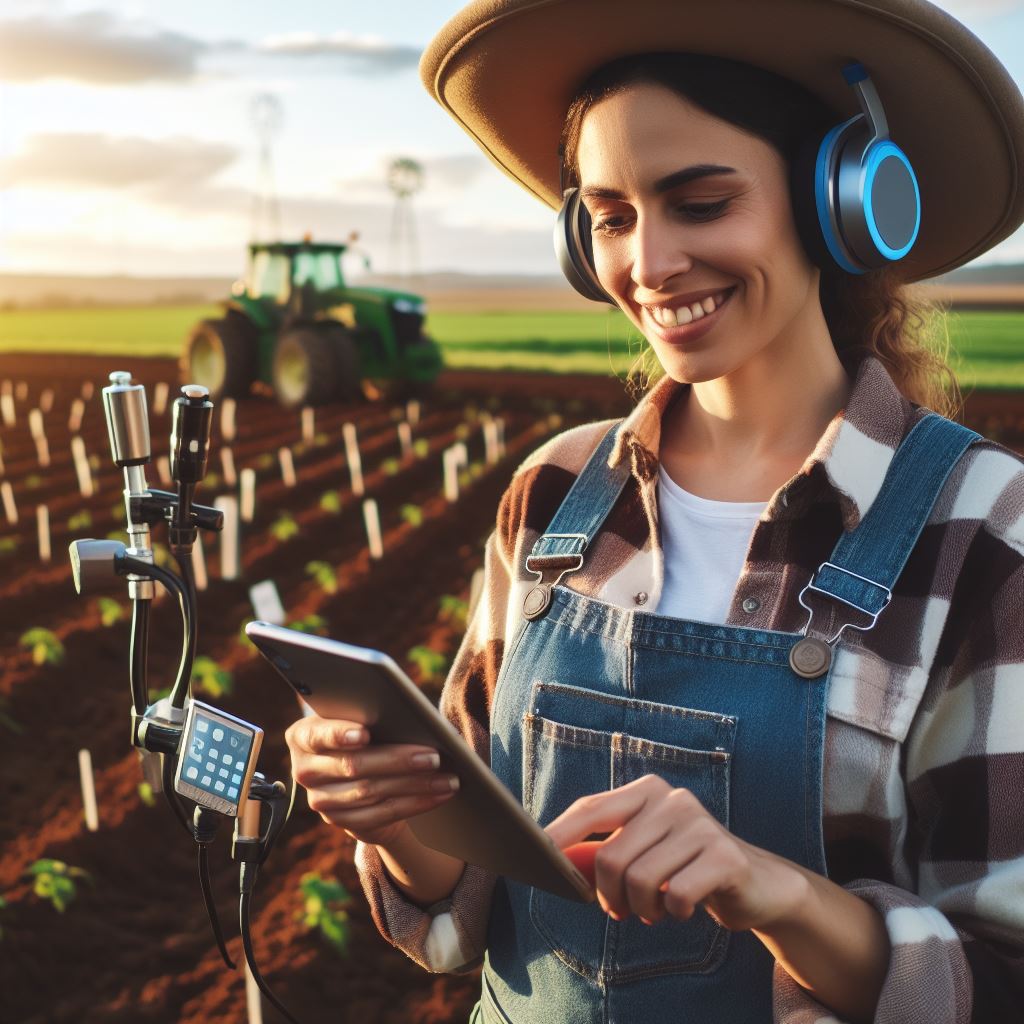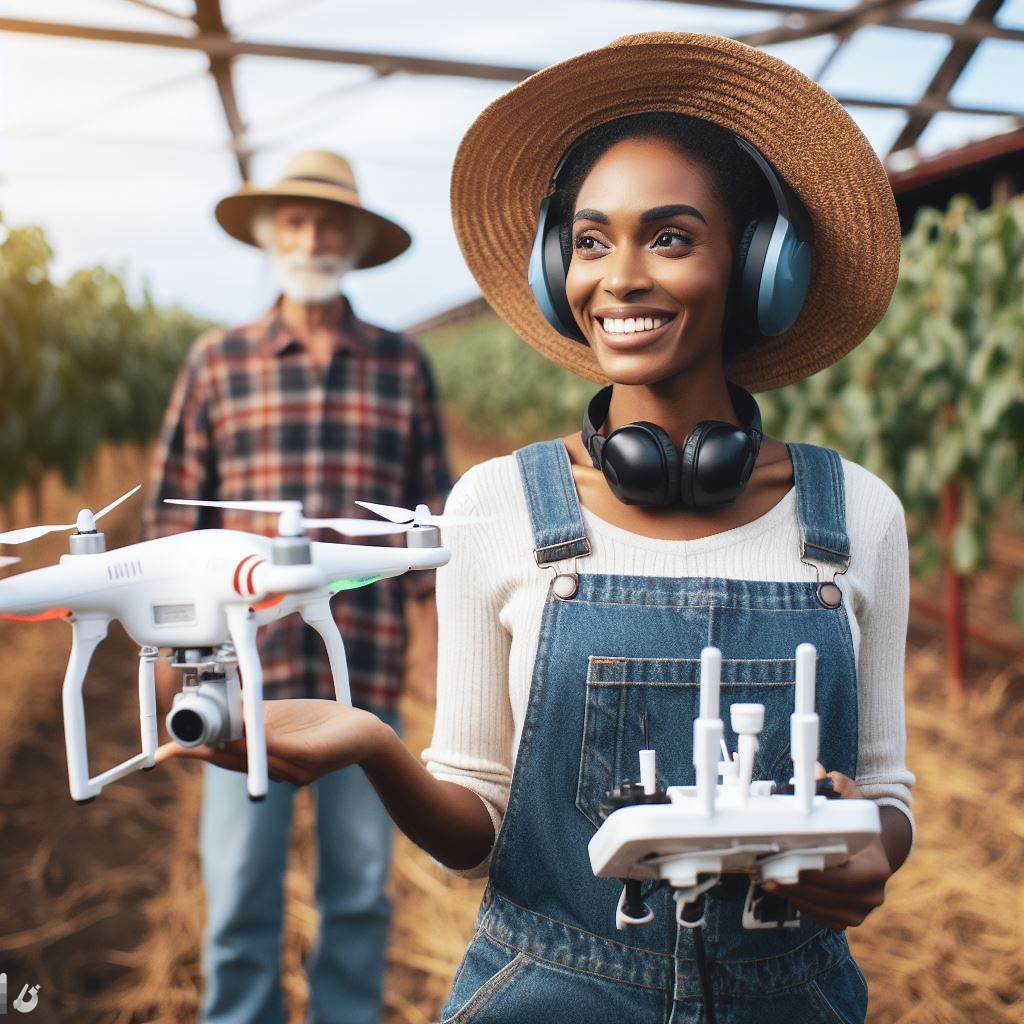Introduction
Brief introduction of soil health monitoring
Soil health monitoring is a crucial aspect in farming and agriculture as it directly impacts crop productivity and sustainability.
Farmers rely on soil health to make informed decisions regarding nutrient management, irrigation, and pest control.
With the rapid advancements in technology, new trends are revolutionizing soil health monitoring.
Importance of soil health for farmers and agriculture in general
Soil health plays a vital role in ensuring the success of agricultural practices.
A healthy soil ecosystem improves water filtration, nutrient availability, and disease resistance, leading to higher crop yields.
Farmers recognize the importance of maintaining an optimal soil environment to achieve long-term profitability and sustainability.
However, traditional soil testing methods can be time-consuming and costly.
They often provide limited information on soil health parameters, making it challenging for farmers to make data-driven decisions.
Fortunately, new technology trends are transforming the way soil health is monitored.
New technology trends revolutionizing soil health monitoring
Emerging technologies such as sensor-based systems, remote sensing, and digital soil mapping are revolutionizing soil health monitoring.
These innovative tools allow farmers to collect real-time data on soil properties, moisture levels, and nutrient content.
With the help of data analytics, farmers can optimize fertilizer applications, irrigation schedules, and precisely target pest control measures.
The integration of advanced technologies not only enhances the accuracy and efficiency of soil health monitoring but also enables farmers to employ precision agriculture techniques.
By taking advantage of these new trends, farmers can improve their crop management strategies, reduce input costs, and minimize environmental impacts.
Basically, soil health monitoring is essential for farmers and agriculture in general.
Transform Your Agribusiness
Unlock your farm's potential with expert advice tailored to your needs. Get actionable steps that drive real results.
Get StartedThe advancements in technology are transforming the way soil health is monitored, providing farmers with real-time data and insights for better decision-making.
By embracing these new tech trends, farmers can achieve sustainable and profitable crop production while preserving the health of their soils.
Overview of Soil Health Monitoring
Soil health monitoring involves assessing the condition of soil in order to ensure its productivity and sustainability.
This process helps farmers and agricultural experts identify any issues that may affect soil fertility and overall crop yield.
The purpose of soil health monitoring is to gather data and information about the physical, chemical, and biological properties of soil.
By monitoring these factors, farmers can make informed decisions regarding fertilization, irrigation, and crop rotation, among other things.
Monitoring soil health is crucial for sustainable agriculture because it enables farmers to maintain and improve the quality of their soil over time.
This is important because healthy soil promotes plant growth, reduces the need for synthetic inputs, and minimizes negative environmental impacts.
Traditional methods to monitor soil health
Traditionally, farmers have relied on several methods to monitor soil health.
These include:
- Visual Assessment: Farmers visually inspect the soil for signs of erosion, compaction, color changes, and presence of pests or diseases. While this method provides some basic information, it is limited in terms of accuracy and fails to measure key soil properties quantitatively.
- Soil Sampling: This involves collecting soil samples from different locations and depths in the field. Laboratory analysis is then conducted to determine soil nutrient content, pH levels, organic matter content, and other parameters. Although this method is more accurate than visual assessment, it is time-consuming and costly.
- Field Indicators: Various indicators such as earthworm populations, soil structure, water infiltration rate, and root development can be observed in the field. These indicators provide insights into soil health and its functioning, but they are subjective and require a trained eye to interpret accurately.
- Crop Performance Monitoring: Farmers observe the growth and performance of crops throughout the growing season. Stunted growth, yellowing leaves, poor yield, and other signs can indicate soil health issues. However, the results may be influenced by other factors like weather conditions and pests.
Despite their usefulness, these traditional methods of soil health monitoring have limitations.
They often lack precision, require time-consuming sample collection and analysis, and do not provide real-time data for immediate decision-making.
This is where new technologies come into play.
New tech trends in soil health monitoring
New tech trends in soil health monitoring are now revolutionizing the agricultural industry.
These technologies utilize remote sensing, sensor networks, data analytics, and machine learning to provide real-time and site-specific information about soil health.
Some examples of these technologies include:
- Soil Moisture Sensors: These sensors measure the water content of soil, allowing farmers to optimize irrigation practices and prevent both under and over-watering.
- Spectroscopy: Using infrared or near-infrared sensors, spectroscopy can quickly analyze soil samples for nutrient content, organic matter, and other properties without the need for laboratory analysis.
- Remote Sensing: Satellite and aerial imagery can provide valuable information regarding soil moisture, temperature, and vegetation cover. This enables farmers to monitor large areas of land efficiently.
- Internet of Things (IoT): Sensor networks and IoT devices can be deployed in the field to continuously monitor soil properties such as temperature, pH, and nutrient levels. This data is then accessible remotely, allowing for immediate decision-making.
Essentially, soil health monitoring plays a crucial role in sustainable agriculture by providing valuable insights into soil fertility and productivity.
While traditional methods have their limitations, new technologies are revolutionizing the way soil health is assessed, allowing for more precise and real-time monitoring.
These advancements will undoubtedly support farmers in making informed decisions and ultimately contribute to the sustainability and productivity of the agricultural sector.
Read: Sustainable Farming via Tech Innovations
Emerging Technologies for Soil Health Monitoring
In recent years, advancements in technology have revolutionized various industries, and soil health monitoring is no exception.
In this section, we will explore the concept of new tech trends in soil health monitoring, including remote sensing technology, soil sensors and probes, and the utilization of drones for mapping and monitoring soil health.
Remote Sensing Technology
Remote sensing technology has emerged as a valuable tool for assessing soil health.
By using satellite or aerial imagery, it allows researchers and farmers to obtain critical information about the condition of the soil without direct contact.
Showcase Your Farming Business
Publish your professional farming services profile on our blog for a one-time fee of $200 and reach a dedicated audience of farmers and agribusiness owners.
Publish Your ProfileThrough the analysis of various spectral bands, remote sensing can identify key indicators related to soil health such as organic matter content, moisture levels, and nutrient availability.
This technology enables large-scale analysis and can help in planning targeted interventions for soil management.
Soil Sensors and Probes
Real-time monitoring of soil health is crucial for efficient farming practices and optimal crop growth.
Soil sensors and probes have become key instruments in acquiring accurate and continuous data about the soil’s physical and chemical properties.
These sensors are embedded in the ground and measure factors such as soil moisture, temperature, pH levels, and the presence of nutrients.
The data collected by these sensors can be transmitted wirelessly to a central database, allowing farmers to make informed decisions about irrigation, fertilization, and other soil management practices.
This technology helps in preventing overuse or underuse of resources, leading to increased productivity and sustainability.
Utilization of Drones
Drones have gained popularity in various fields, and their application in soil health monitoring is no exception.
Equipped with high-resolution cameras and multispectral sensors, drones can capture detailed images and gather precise data about soil characteristics.
They can cover large areas quickly and efficiently, offering a cost-effective alternative to traditional manual soil sampling methods.
The collected data can be used for creating detailed soil maps, identifying areas of concern, and monitoring changes in soil quality over time.
This information allows farmers to implement targeted soil management strategies and improve overall productivity.
In general, new tech trends are transforming soil health monitoring by providing innovative tools for accurate and real-time assessment.
Remote sensing technology, soil sensors and probes, and the utilization of drones offer valuable insights into soil health, enabling farmers to make informed decisions about soil management practices.
By harnessing the power of these emerging technologies, we can enhance crop yield, conserve resources, and cultivate healthy and sustainable soils for future generations.
Read: Drones in Agri: Irrigation Game Changer
See Related Content: Drones in Farms: Changing the Agri Landscape
Benefits of New Tech Trends in Soil Health Monitoring
In recent years, emerging technologies have revolutionized soil health monitoring, providing numerous benefits to farmers and agronomists alike.
By utilizing the latest tech trends, monitoring soil health has become more efficient, cost-effective, and accurate.
Advantages of Using Emerging Technologies for Soil Health Monitoring
- Improved Accuracy: New tech trends enable more precise measurements of crucial soil parameters, such as nutrient levels and pH.
- Time and Cost Savings: Traditional soil sampling methods are labor-intensive and time-consuming. With emerging technologies, monitoring can be done quickly and at a lower cost.
- Remote Monitoring: Wireless sensors and probes allow farmers to monitor soil health remotely, eliminating the need for manual data collection.
- Easy Data Collection: Automated data collection eliminates human error and ensures consistent and reliable information.
- Enhanced Decision-Making: Real-time data provided by sensors and probes enable farmers to make informed decisions promptly.
New Tech Trends: Cost-Effective and Efficient Monitoring
One of the significant advantages of new tech trends in soil health monitoring is the cost-effectiveness and efficiency they offer.
Traditional soil sampling methods require extensive labor and are often expensive.
However, with emerging technologies, such as remote sensing and drone imagery, farmers can collect data from large areas of land quickly and without the need for manual labor.
This results in significant cost savings while ensuring accurate and up-to-date information about soil health.
Digital soil mapping is another emerging technology that allows for cost-effective monitoring.
By utilizing geostatistical analysis and remote sensing data, farmers can create detailed soil maps that show variations in soil properties across their fields.
This enables targeted and efficient management practices, such as variable rate nutrient application.
Real-Time Data for Informed Decision-Making
The availability of real-time data from sensors and probes is a game-changer in soil health monitoring.
Traditional soil sampling methods often provide delayed results, making timely decision-making challenging.
With new tech trends, farmers can receive instant updates on soil moisture levels, temperature, nutrient content, and other parameters.
This real-time data allows for quick adjustments in irrigation, fertilizer application, and other management practices.
As a result, crops can be cared for more effectively, leading to improved yields and decreased input costs.
Early Detection of Soil Health Issues and Preventive Measures
Another significant benefit of new tech trends in soil health monitoring is the potential for early detection of issues and the ability to take preventive measures.
Prompt identification of soil health issues, such as nutrient deficiencies or pH imbalances, can help prevent yield losses and minimize environmental impacts.
Emerging technologies offer continuous monitoring, allowing farmers to identify changes in soil health parameters as they occur.
By setting up alerts and notifications, farmers can take immediate action to address any emerging issues.
This proactive approach can save both time and resources compared to reactive measures taken once the damage has already occurred.
In essence, the benefits of new tech trends in soil health monitoring are undeniable.
From improved accuracy and cost-effectiveness to real-time data availability and early detection of issues, emerging technologies have transformed the way farmers monitor soil health.
By embracing these trends, farmers can make informed decisions, increase productivity, and ensure the long-term sustainability of their agricultural practices.
Read: Automated Farming: Pros & Cons Explored
Showcase Your Farming Business
Publish your professional farming services profile on our blog for a one-time fee of $200 and reach a dedicated audience of farmers and agribusiness owners.
Publish Your Profile
Challenges and Limitations of New Tech Trends
New tech trends in soil health monitoring offer promising solutions to improve agricultural practices and environmental sustainability.
However, these innovations also come with their own set of challenges and limitations that need to be acknowledged and addressed:
Initial Cost
Purchasing and implementing new technologies for soil health monitoring can be costly, especially for small-scale farmers and resource-limited regions.
The high upfront investment may deter adoption.
Training and Expertise
Interpreting and utilizing the data collected by these new tech tools requires specialized training and expertise.
Farmers and technicians need to be trained in data analysis and interpretation to make informed decisions.
Data Interpretation
The complex data provided by these technologies may be difficult to interpret without proper training.
Without the ability to correctly interpret the data, its usefulness is limited, and potential benefits cannot be fully realized.
Environmental Limitations
Soil health monitoring technologies may have limitations in specific environmental conditions, such as extreme temperatures, high humidity, or certain soil types.
These limitations can affect the accuracy of monitoring results.
Technical Limitations
New tech trends can face technical challenges, such as sensor malfunction or data connectivity issues.
These limitations can impact the reliability and consistency of the data collected.
Compatibility with Existing Systems
Integrating new technologies with existing farm management systems can be challenging.
Compatibility issues between different platforms and software may arise, requiring adjustments and additional investments.
Scalability
The scalability of new tech trends in soil health monitoring is essential for widespread adoption and impact.
Ensuring that these technologies are accessible and affordable to farmers on different scales is crucial.
Data Security and Privacy
Collecting and storing large amounts of data raises concerns about data security and privacy.
Farmers and researchers must ensure that the data collected is protected and used responsibly.
Calibration and Maintenance
Regular calibration and maintenance of soil health monitoring equipment are necessary for accurate results.
Proper calibration protocols should be followed, and maintenance needs to be performed to avoid measurement errors.
Education and Awareness
Educating farmers and stakeholders about the benefits and potential limitations of new tech trends in soil health monitoring is crucial.
Raising awareness can promote informed decision-making and wider adoption.
In a nutshell, while new tech trends in soil health monitoring hold great potential, they also face several challenges and limitations.
Addressing these issues, such as the initial cost, training needs, environmental and technical limitations, is necessary to ensure the successful adoption and realization of their benefits.
By overcoming these barriers, farmers can make data-driven decisions, enhance productivity, and contribute to sustainable agricultural practices.
Read: Climate Smart Agri: Tools & Techniques
Conclusion
Recap of the importance of soil health monitoring for farmers
Soil health monitoring plays a crucial role in the success of farmers.
By regularly assessing the health of their soil, farmers can make informed decisions about nutrient management and crop selection, leading to higher yields and healthier crops.
Emphasis on the potential of new tech trends in improving soil health monitoring
The emergence of new technological trends has further enhanced soil health monitoring.
Innovations such as remote sensing, sensor networks, and advanced analytics provide farmers with real-time data on soil conditions, allowing them to detect issues early and take necessary actions.
It is essential for farmers to embrace these new tech trends and incorporate them into their farming practices.
By doing so, they can optimize resource utilization, minimize environmental impact, and ensure sustainable agriculture.
Encouragement for farmers to explore and adopt the emerging technologies in soil health monitoring for sustainable agriculture
Therefore, farmers are encouraged to explore and adopt emerging technologies in soil health monitoring.
By utilizing these tools, farmers can improve their understanding of soil health, identify potential problems, and implement targeted solutions.
This would not only benefit their own farm’s productivity but also contribute to the overall goal of sustainable and environmentally friendly agriculture.




